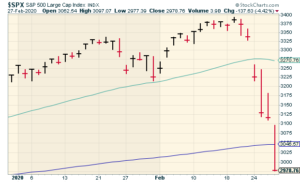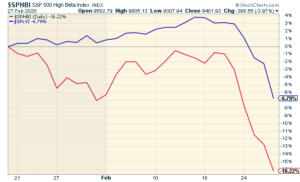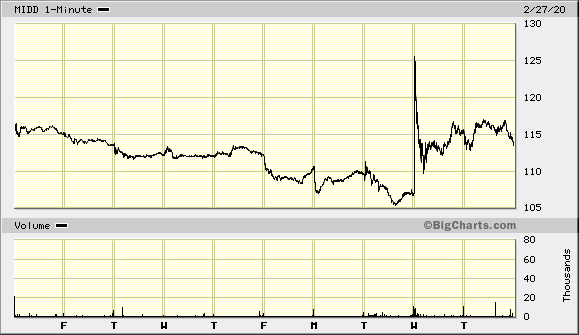CWS Market Review – February 28, 2020
“Markets trend only about 15 percent of the time; the rest of the time they move sideways.” – Paul Tudor Jones
In last week’s issue, I wrote about the market’s rally, “I want to urge caution. We’ve had some nice gains, but don’t get too complacent. The bear loves to knock you over the moment you get too comfortable.”
Clairvoyance? Nope. I was just being prudent, but my timing was spot on. What a raucous week on Wall Street! The fears of the coronavirus have finally landed on Wall Street and the S&P 500 has fallen for six days in a row. If you’re keeping score, this is the 26th pullback of more than 5% since the bull market began 11 years ago.
Let’s review the damage. On Monday, the S&P 500 lost -3.35% for its worst loss in more than two years. Then on Tuesday, it fell by -3.03%. On Thursday, the S&P 500 plunged for a loss of -4.42%. That was its biggest fall in 8½ years.
From its closing high on the Wednesday before last, the S&P 500 has lost just over 12%. That’s in six trading sessions. This is the fastest correction (over 10% loss) in history. There’s an old saying on Wall Street, “a bull walks up the steps and a bear jumps out the window.” Boy is that true.
Here’s an example of how irrational markets have been. Shares of ZOOM Technologies (ZOOM) jumped more than 50% on the belief that its video-conferencing technology would benefit from the coronavirus.
One small problem. That’s the wrong company!
The company that makes Zoom is Zoom Video Communications. Their ticker is ZM.
ZOOM Technologies is not longer in business. In fact, it hasn’t been in business for years!
Traders didn’t care. At its high, ZOOM was up more than 56% on Thursday. Let me reiterate, this is a company that’s no longer in business.
In this week’s CWS Market Review, I’ll try to bring some sanity back to Wall Street. Fortunately, our Buy List has been outperforming lately (meaning down less). Since February 20, the S&P 500 has lost 11.69% while our Buy List has fallen 9.75%. I realize talking about falling less may sound odd, but it’s an important aspect of long-term investing success.
I’ll go over our three Buy List earnings reports from this week. They were all quite good. At one point, Middleby jumped for a 20% gain. I’ll have the details in a bit. I’ll also preview next week’s earnings report from our favorite deep-discounter, Ross Stores. But first, let’s try to make sense of this week’s mayhem.
The Fastest Correction in History
I certainly won’t say that I have any expertise in public health, so I can’t say much about what will eventually happen with coronavirus. But I do know something about financial markets, and they’ve been very anxious this week. The yield on the 10-year Treasury fell below 1.25%. That’s an all-time low.
This week has seen some of the most severe few days since the Financial Crisis. Still, we’ve seen many weeks worse than this. We should also bear in mind how well the market had done before now. The S&P 500 is still up over 18% since the start of 2019. As far as one-day losses go, in percentage terms, Thursday doesn’t crack the top 100.
What’s struck me is the big divide among the kinds of stocks feeling the most pain. Stocks that tend to bounce around a lot have been down the most whereas stocks that are more stable have suffered the least. Some of this is to be expected simply due to the nature of these stocks. But the gap between these groups has been especially wide this week even in regard to the overall market.
Here’s a chart of the S&P 500 High Beta Index (red) along with the S&P 500 Low Vol index (blue):
In plainer terms, investors have been dumping risky stocks at a mad pace. In return, they’re running toward anything that looks safe. One beneficiary has been bonds. The yield on U.S. Treasuries has plunged. I think there’s a good chance the Fed will cut rates before the next meeting. In fact, it could be a 0.5% cut. Of course, that’s not exactly a vaccine for coronavirus, but it would calm Wall Street’s nerves.
What to do now? First, whatever you do, do not panic and sell. That would be a huge mistake. As Peter Lynch said, “The real key to making money in stocks is not to get scared out of them.” Make sure you have a well-diversified portfolio of high-quality stocks. The downturn has given us some bargains. AFLAC (AFL), for example, is going for 10 times earnings. Disney (DIS) is another stock going for a discount.
Now let’s take a look at our Buy List earnings from this week.
Trex Is a Buy up to $107 per Share
This week, we had our final three Buy List earnings reports for this earnings season. After the close on Monday, Trex (TREX) reported Q4 earnings of 61 cents per share. That was 10 cents more than estimates. Sales rose 18% to $165 million. The company had been expecting sales of $160 million. For the year, Trex earned $2.47 per share on sales of $745 million.
CEO James E. Cline said, “Fourth-quarter results were in line with our expectations for strong double-digit sales growth and sequential gross margin expansion.” This was a very good quarter for Trex.
For 2020, Trex expects “strong double-digit sales growth.” For Q1, they expect sales of $200 million which is an 11% increase over last year. During 2019, Trex bought back 500,000 shares of stock at an average price of $77 per share.
The stock rose on Tuesday while most everything else was down. On Wednesday, Trex pulled back 5% as a number of analysts trimmed their Q1 EPS forecasts. The shares rallied again on Thursday. This week, I’m raising my Buy Below on Trex to $107 per share.
One other note. James E. Cline will be retiring as CEO later this year. The board has chosen Bryan Fairbanks to be the new CEO.
Our final two reports came on Wednesday. On Wednesday morning Middleby (MIDD) released a fantastic earnings report. At one point on Wednesday morning, the shares were up over 20%.
For Q4, the company made $2.00 per share. That crushed estimates of $1.71 per share. Quarterly sales rose 4.1% to $787.6 million. For the year, Middleby made $7.02 per share. Business is going very well.
CEO Timothy FitzGerald said, “Over the past year we made significant investments in new product innovations addressing these categories and are pleased to see growing interest as we enter 2020. We are well-positioned with a much-improved backlog as we closed out 2019 and are confident it will translate into sales and profitability growth for the upcoming year.”
The shares gained 8% on Wednesday. I’m keeping my Buy Below on Middleby at $120 per share.
After the closing bell, Ansys (ANSS) reported Q4 earnings of $2.24 per share. That was a great number. Wall Street had been expecting $1.98 per share. For the year, Ansys made $6.58 per share.
Ajei Gopal, Ansys President & CEO, said, “Q4 was an outstanding quarter concluding a stellar 2019. We grew double digits across revenue and ACV for the quarter and the year, and I am confident we are tracking towards our 2022 objective of $2 billion in ACV.”
Now for the bad news. Ansys gave poor guidance for Q1 and the whole year. Bear in mind, they could be playing it safe. For Q1, Ansys sees revenues ranging between $300 million and $320 million and earnings between 75 and 88 cents per share. Wall Street had been expecting $360 million and earnings of $1.36 per share.
For the year, Ansys sees revenues between $1.64 billion and $1.70 billion and EPS between $6.19 and $6.71. Wall Street had been expecting $1.68 billion and earnings of $6.76 per share. This implies that much of the Q1 weakness will be made up later in the year,
In early trading on Thursday, Ansys was down as much as 12.8%. It later rallied some to close down by 9.6%. I’m keeping my Buy Below at $270 per share. Stick with Ansys-it’s a great company.
Ross Stores Earnings Preview
Ross Stores (ROST) will report its Q4 earnings on Monday, March 3. This is for their fiscal year which ends at the end of January. I’m a big fan of this deep discounter.
Three months ago, Ross earned $1.03 per share. That was well above their own forecast of 92 to 96 cents per share. Quarterly sales were up 8%, but the really impressive stat was comparable-store sales. For Q3, that was up 5%. The company had been expecting a gain of 1% to 2%.
Q4 is the biggie for Ross. That covers the holiday shopping season: November, December and January. Ross expects Q4 earnings of $1.20 to $1.25 per share which includes a tax benefit of two cents per share. Again, Ross expects same-store sales of 1% to 2%. (They always say that.) The Q4 range implies a full-year 2019 range of $4.52 to $4.57 per share. Ross Stores is a very good stock.
Buy List Updates
I wanted to add a quick note on Disney (DIS). This week, Robert Iger said he’ll be retiring. He’s been a remarkable leader for the entertainment powerhouse. Shares of Disney took a hit on the news. I should add that he’s not disappearing. Instead, Iger will serve as executive chairman. The stock has also lagged due travel concerns. DIS is lower now than where it was in mid-2015. Disney is a very good buy here. I’m lowering my Buy Below on Disney to $130 per share.
On Thursday, Silgan (SLGN) raised its quarterly dividend by 9% to 12 cents per share. This is their 16th consecutive annual dividend increase. The dividend is payable on March 31 to shareholders of record on March 17. Based on Thursday’s close, that works out to a yield of 1.63%. That’s more than a 20-year Treasury.
That’s all for now. Next week, we’ll get all the key turn-of-the-month econ reports. The ISM Manufacturing report comes out on Monday. The ADP jobs report is on Wednesday. Weekly jobless claims are due out on Thursday. That leads up to Friday when the February jobs report is due out. Be sure to keep checking the blog for daily updates. I’ll have more market analysis for you in the next issue of CWS Market Review!
– Eddy
Posted by Eddy Elfenbein on February 28th, 2020 at 7:08 am
The information in this blog post represents my own opinions and does not contain a recommendation for any particular security or investment. I or my affiliates may hold positions or other interests in securities mentioned in the Blog, please see my Disclaimer page for my full disclaimer.
-
-
Archives
- April 2025
- March 2025
- February 2025
- January 2025
- December 2024
- November 2024
- October 2024
- September 2024
- August 2024
- July 2024
- June 2024
- May 2024
- April 2024
- March 2024
- February 2024
- January 2024
- December 2023
- November 2023
- October 2023
- September 2023
- August 2023
- July 2023
- June 2023
- May 2023
- April 2023
- March 2023
- February 2023
- January 2023
- December 2022
- November 2022
- October 2022
- September 2022
- August 2022
- July 2022
- June 2022
- May 2022
- April 2022
- March 2022
- February 2022
- January 2022
- December 2021
- November 2021
- October 2021
- September 2021
- August 2021
- July 2021
- June 2021
- May 2021
- April 2021
- March 2021
- February 2021
- January 2021
- December 2020
- November 2020
- October 2020
- September 2020
- August 2020
- July 2020
- June 2020
- May 2020
- April 2020
- March 2020
- February 2020
- January 2020
- December 2019
- November 2019
- October 2019
- September 2019
- August 2019
- July 2019
- June 2019
- May 2019
- April 2019
- March 2019
- February 2019
- January 2019
- December 2018
- November 2018
- October 2018
- September 2018
- August 2018
- July 2018
- June 2018
- May 2018
- April 2018
- March 2018
- February 2018
- January 2018
- December 2017
- November 2017
- October 2017
- September 2017
- August 2017
- July 2017
- June 2017
- May 2017
- April 2017
- March 2017
- February 2017
- January 2017
- December 2016
- November 2016
- October 2016
- September 2016
- August 2016
- July 2016
- June 2016
- May 2016
- April 2016
- March 2016
- February 2016
- January 2016
- December 2015
- November 2015
- October 2015
- September 2015
- August 2015
- July 2015
- June 2015
- May 2015
- April 2015
- March 2015
- February 2015
- January 2015
- December 2014
- November 2014
- October 2014
- September 2014
- August 2014
- July 2014
- June 2014
- May 2014
- April 2014
- March 2014
- February 2014
- January 2014
- December 2013
- November 2013
- October 2013
- September 2013
- August 2013
- July 2013
- June 2013
- May 2013
- April 2013
- March 2013
- February 2013
- January 2013
- December 2012
- November 2012
- October 2012
- September 2012
- August 2012
- July 2012
- June 2012
- May 2012
- April 2012
- March 2012
- February 2012
- January 2012
- December 2011
- November 2011
- October 2011
- September 2011
- August 2011
- July 2011
- June 2011
- May 2011
- April 2011
- March 2011
- February 2011
- January 2011
- December 2010
- November 2010
- October 2010
- September 2010
- August 2010
- July 2010
- June 2010
- May 2010
- April 2010
- March 2010
- February 2010
- January 2010
- December 2009
- November 2009
- October 2009
- September 2009
- August 2009
- July 2009
- June 2009
- May 2009
- April 2009
- March 2009
- February 2009
- January 2009
- December 2008
- November 2008
- October 2008
- September 2008
- August 2008
- July 2008
- June 2008
- May 2008
- April 2008
- March 2008
- February 2008
- January 2008
- December 2007
- November 2007
- October 2007
- September 2007
- August 2007
- July 2007
- June 2007
- May 2007
- April 2007
- March 2007
- February 2007
- January 2007
- December 2006
- November 2006
- October 2006
- September 2006
- August 2006
- July 2006
- June 2006
- May 2006
- April 2006
- March 2006
- February 2006
- January 2006
- December 2005
- November 2005
- October 2005
- September 2005
- August 2005
- July 2005



 Eddy Elfenbein is a Washington, DC-based speaker, portfolio manager and editor of the blog Crossing Wall Street. His
Eddy Elfenbein is a Washington, DC-based speaker, portfolio manager and editor of the blog Crossing Wall Street. His